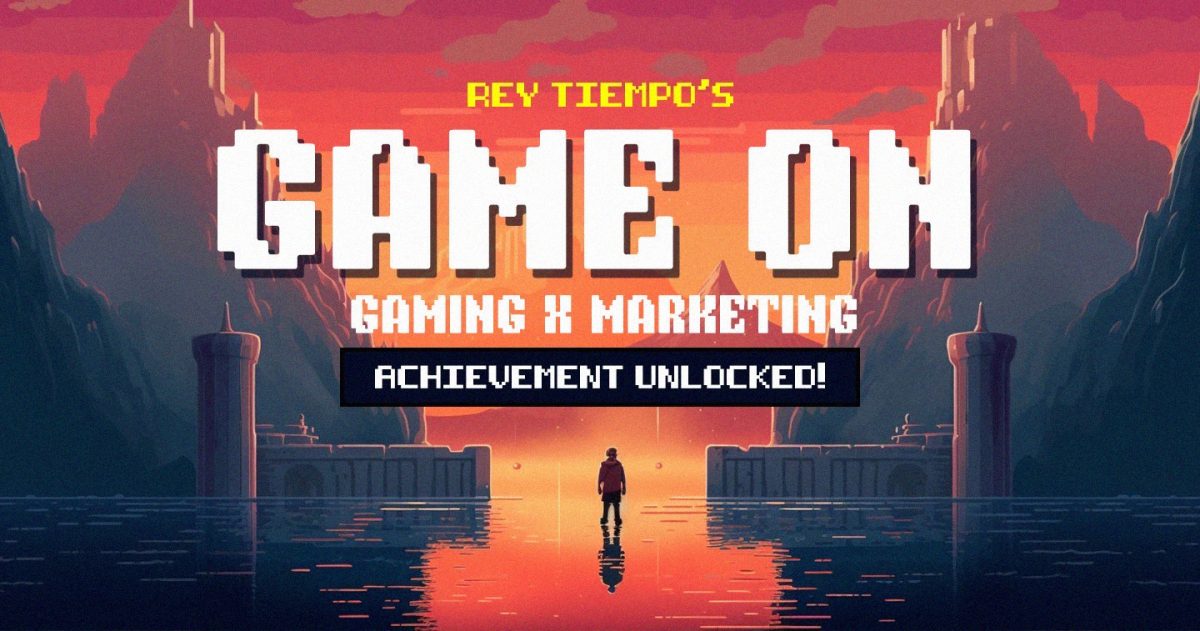MANILA, PHILIPPINES — As we officially begin the award season for advertising this year, and more and more shows are adding dedicated Gaming categories to their lineups, Game On captain Rey Tiempo sets his sights on recent Gaming X Marketing works to keep an eye on – for better or for worse. In the latest Achievement Unlocked story, Rey looks back on four campaigns that caught his attention this season, and what they did right and wrong from his distinct gamer and advertising POVs.
The industry awards season is in full swing! And with it, the promise of groundbreaking new creative work that will be setting the benchmark for the industry (at least for the rest of the year.)
And of course, here at Game On, of particular interest are the Gaming categories across the industry’s biggest shows: Spikes Asia, with the debut of Gaming Spikes, as well as the inclusion of New Realities, Emerging Tech, virtual worlds and innovation in other categories.
The rest of the creative community will continue recognizing excellence in creative Gaming work, with the ADC Awards debuting its own Gaming category, and the evolution of existing Gaming categories in D&AD, The One Show, and of course the Cannes Lions’ Entertainment in Gaming, entering its second year.
What a time for Gaming X Marketing!
As always with Achievement Unlocked, we will be looking at Creative Gaming work and dissecting them through the Gaming lens as well as the Advertising lens.
Check out the previous work featured in Achievement Unlocked, here:
- Gaming Cannes: 2023 Cannes contenders in gaming
- Achievement unlocked: The gamingXmarketing work that caught Rey Tiempo’s Game On eye
Let’s-a-go!
ADVIL “Head Settings”
The Gaming POV:
Let me take a wild guess: there are legit hardcore PC gamers in this team, yes? The work very much speaks for itself, from the gamer side of things. To combat what they’ve identified as “gaming headaches,” Advil releases “Head Settings,” or a series of suggested detailed customization tweaks for PC games.
The brand has painstakingly crafted unique settings for each of the most popular gaming genres – meaning, there are recommended tweaks to avoid headaches specific to role-playing games, to third-person shooters, to first-person shooters, to sports games, to racing games, etc. Advil seeks to connect with the audience that clearly benefits from its product (no gamer wants a headache while playing), and it pays off in an authentic way.
The campaign clearly shows that Advil knows its market really well. These detailed settings are exactly what PC gamers live for. Hardcore gamers know this: a big part of the PC gaming experience is the endless customization options per game, per device, per graphics card used, per CPU load – it goes on and on! I often refer to it as a “mini-game” of sorts, to get the PC game even running on your system.
These “Head Settings” are just another set of optional tweaks, but while recommended optimization is usually needed for games to run better (especially for those who want to play competitively), this time it’s for the very specific purpose of avoiding headaches. Brilliant!
The Advertising POV:
The use of experts, both from the medical as well as the gaming side, is spot on and they’re believable enough as credible resources. The main site explains the idea very clearly, and is also the main source of information for this effort, where you can download the settings, and even some useful tips on improving your gaming environment. And from the press pickups, especially in the gaming side, we do get the sense that the community really has taken this on. The amusing explainer video is great for now and does its job well.
But what I am really looking forward to is how they will tell the complete story, together with the results and the impact it has created for the market as well as for the brand. Because as much as this is a fun effort that targeted the PC gaming audience head-on (yup!), the objective should be to prove that the settings really DO work (research and lots of actual testimonials), that the settings really do prevent gaming headaches, and in each of the gaming genres they’ve identified (otherwise, why bother with unique settings?). Ultimately, the results would reflect heavily on the brand’s efficacy.
KFC X Street Fighter 6
The Gaming POV:
I am a huge Street Fighter fan, and I do not tire of saying that every chance I get. I have been playing since the World Warrior days. I grew up in the arcades. I collect arcade sticks and special fighting game controllers. I (try to) play in tournaments. I have seen the fighting game community rise from the early days of Evo, the explosion during the Street Fighter IV days, the maturity of the Street Fighter V era, and now with the series’ latest, the blossoming of Street Fighter 6. I have written extensively how this newest version of the series is by far the most innovative and exciting, with new features and new game modes that are fast becoming the standards in the genre.
And yes, of course, I have been watching and monitoring closely the Gaming X Marketing opportunities in the game since it came out last year. We have witnessed the Chipotle and Onitsuka Tiger partnerships in the form of promos and some in-game items — all official tie-ups, which I imagine took a considerable amount of resources to pull off. But I was continually on the lookout for something more, something creatively new. So when I saw this effort by KFC, I was intrigued and genuinely excited. But honestly… It left me confused.
First off, using a game’s “create a character” feature to mimic a brand icon, has honestly been done before, and has been done a lot. We’ve seen Wendy’s do this in Fortnite (a Cannes Lions Grand Prix winner), then we’ve seen them do it again in Super Wendy’s world, where the brand’s icon was recreated in various other video game worlds. We’ve also seen lots of other creative gaming work where popular real world characters were recreated in sports games. So seeing the Colonel as another custom character is honestly nothing special. It is also confusing to read some of the press releases, especially the ones that make it appear as if the Colonel has officially joined the Street Fighter 6 roster, which is simply misleading. Created characters are like your avatars in the game, usable only in some one player modes, and definitely not in the main competitive mode with the official roster of playable characters.
It gets more confusing when the brand started talking about executing combos. When creating characters in this game, you will get a choice of which Street Fighter 6 character moves you can assign. So which character’s combos exactly is the brand talking about? And which type of control scheme?
Street Fighter 6 introduced Modern controls, where the inputs are simplified, and where combos are easier to pull off. If the team behind it is talking about that, then that would have offered a far simpler challenge to players, and they would have given so many free gift cards. I have so many questions, and unfortunately, not a lot of answers out there.
But perhaps the most puzzling thing for me, is that I have not heard of this effort outside the PRs, definitely not within the game itself and nothing in the communities; quite bizarre especially for me, who has not stopped playing the game since its launch.
The Advertising POV:
Let it not be said that puns do not have a place in the current creative advertising landscape. Sometimes, when done in different platforms, they may come out as something – gasp – new. In this case, the “recipe” for creating a character becomes the vehicle to recreate an icon known for creating its own iconic “recipes.” And the “combos” executed to pummel your opponents in fighting games become your gateway to enjoy mouthwatering “combo” meals in the real world. It’s all in good fun, and mostly it works, just for the sheer silliness of seeing the Colonel in this environment. As a small one-off promo meant to entice players of this game to fill their stomachs by exerting a bit of effort, it does the job.
VASELINE “SKINS FOR SKIN”
The Gaming POV:
I am watching the story of this campaign through the case film, from the numerous pickups and industry coverage. And immediately, I can see the brand running into one of the most common challenges in trying to present and explain a gaming case – resorting to sweeping generalizations to highlight the importance of a certain point. It claims “gamers’ most valuable possessions are their skins.” Which is simply not true for all gamers (certainly not true for me and those in my communities; my most valuable possessions are my arcade sticks, for example.)
These sweeping generalizations really only come from (most) marketers’ basic misunderstanding of gaming and gamers – that “gaming” is one homogenous whole, and that “gamers” is one homogenous demographic. This cannot be farther from reality: there are diverse sets of gamers, communities, interests, motivations, as there are games, game genres, peripheral interests, etc. It simply does not do the gaming population justice to lump all of us together in one convenient sentence. That being the case, let’s still give this one a chance, and try to view it from the gamers who do value their skins the most.
They present an interesting analogy: that in-game skins are as precious as skin in real life, particularly for burn victims who are suffering the real world horrors of needing skin transplants. And that “donating skin” in games can be somehow equated to “donating skin” in real life. Admittedly, I am struggling to find the right emotions to connect the different usages of “skin.” The main problem lies here: the “value” of owning skins in video games involves a totally different motivation, background, circumstances and yes most especially a different set of emotions, compared to the “value” of skins in real life, especially used in the grim context being presented in the case.
While at first, real world similarities might lead to seemingly great ideas when executed in gaming (and some great cases are out there), it is vastly more important to first understand the authentic gaming-endemic nuances behind such similarities. And all it takes is real, honest-to-goodness participation: just play the games, immerse yourselves in the communities. And then eventually, you’ll find out – they’re not similarities in the first place.
Advertising POV:
See previous work mentioned, on using puns in gaming. Unfortunately, not all puns can work as we intend it to, especially if the emotions involved are completely different. The campaign did seem to do its job of raising awareness, considering all the other peripheral materials around the central gaming work. And while efforts to support victims are definitely worthy causes for the brand, and this does still feel like a win, I feel there are much better-suited platforms to more effectively reach the objectives presented.
DOVE “CODE MY CROWN”
The Gaming POV:
Absolutely brilliant. Exactly the kind of Gaming X Marketing work that excites, stuns, leaves gamers like me in awe. It gets all the emotions right. Extremely on point, with the described gamer demographic experience. Relevant and timely. Culture-changing work. I am excited to start seeing this implemented in the myriad of games I am and will be playing. Congratulations to the creative team behind this campaign.
The Advertising POV:
It’s a winner. Thank you for doing this, Dove.
ABOUT GAME ON AND THE CREATORS

Rey Tiempo is the most awarded creative gaming brand marketer in Asia, with accolades from the world’s biggest award shows. A hardcore gamer since childhood, Rey is quite possibly the industry’s biggest gamer. A veteran creative head with over 25 years’ experience, Rey founded and created “Game On” the first and only industry column of its kind with original content on Gaming X Marketing, the increasingly rich interplay between gaming and creative marketing.
Rey preaches his motto “Playing while working” while leading industry talks on tech and the future of creative marketing in gaming. Currently playing: Foamstars, Helldivers 2, Pacific Drive.
Column artwork by Dennis Nierra, Creative Director at BBDO Guerrero. Currently playing: Diablo IV.









